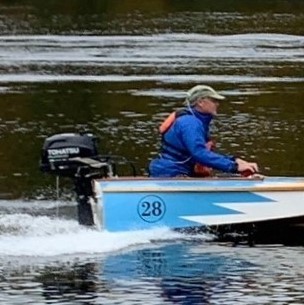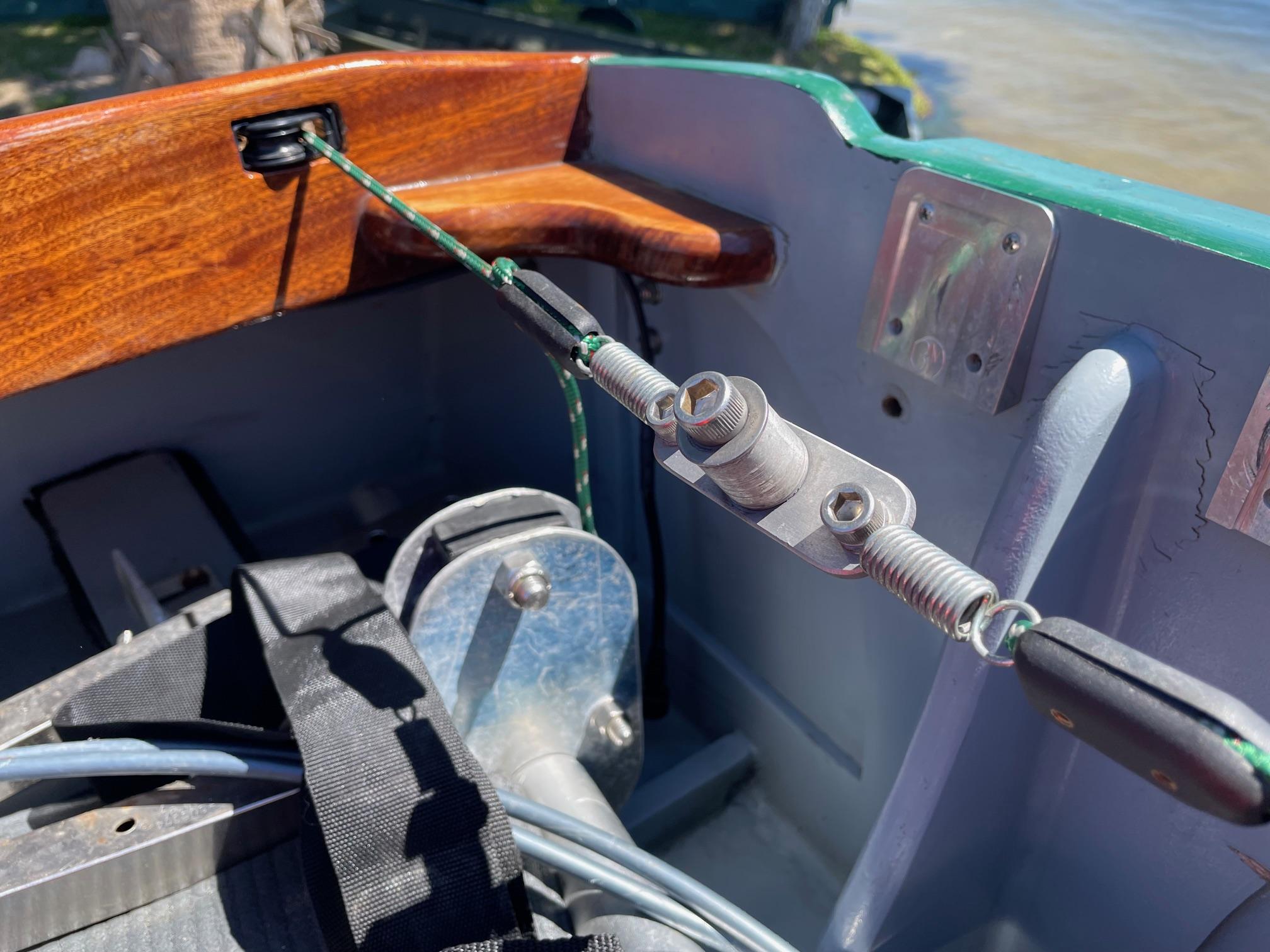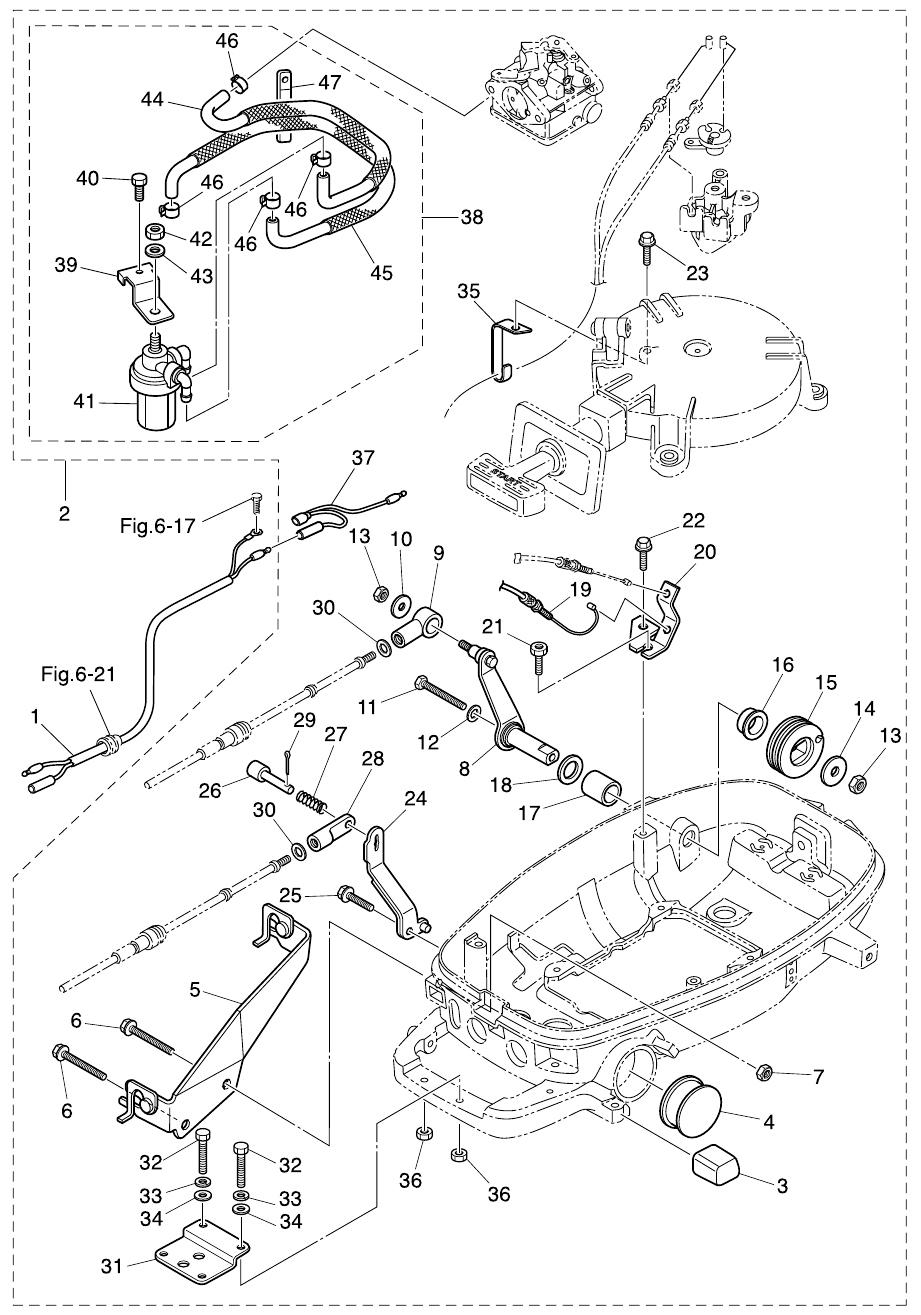Forum Replies Created
-
AuthorPosts
-
 fallertonParticipant
fallertonParticipantThere are a number of ways to skin this cat, none as “neat” as the one used by two Cocktail Class innovators from Fla. and seen in the steering of “Neat” and “Five O’Clock Somewhere.” The custom 3-hole strap connects to the Tohatsu’s s.s. bracket (that bracket is provided with the remote control adapter kit and fastens to the front carry handle.) A custom s.s. or alum. spacer takes up some of the gap between the Tohatsu’s carry handle and the rope’s natural path (a straight line between the fairleads through the coamings.) Add some shoulder washers to facilitate swivel action in the connection and eliminate excessive slop in the connection.

 fallertonParticipant
fallertonParticipantAs the Class was formed and is being populated with one-brand of motors over a few years now, we have not heard any objections, only positive comments. No alternate brands were included, partly because they may or may not have deviations now or in the future. We don’t know. And as a benefit, we are not burdened with keeping tabs on that.
The simplicity of the one-motor brand is one of the class’s strong selling points! With one-motor brand, it is most likely that no one will have an edge. If a driver is accustomed to looking at someone’s stern, he can assume it is probably a matter of driver skill that got him there.
So, imagine a situation in which everyone has Tohatsu’s, except one driver has an Evinrude or Mercury. If one of the Tohatsu drivers consistently finds himself behind THAT boat with the re-labelled motor, he will start to think, understandably so, that it might not all be a matter of driver skill. And no one will be able to convince him otherwise. Phht! The magic is lost for another attempt at one-class racing. And you can’t put that back in the toothpaste tube.
The alternative argument being emphasized suggests the reason for permitting other brands is to prevent someone from circumventing the rule. I think that “logic” may have been given in jest. Obviously, that’s no reason to change a rule. If the remarks were serious, we had better up the ante with better trophies or start handing out cash prizes to make all that effort worthwhile!
“And that’s all I have to say about that!” F. Gump
 fallertonParticipant
fallertonParticipantThe 6hp Tohatsu 4-Stroke Class was created to facilitate, as close as possible, “One-Design” racing conditions, including motors that are, as much as possible, identical in performance. Anything that might diminish uniformity of equipment, or even weaken the “One-Design” perception of the class would be detrimental to the value and the popularity the class enjoys.
If CCWBRA were to add a second or third brand of motor to the class it would require us to take on the added responsibility of periodic research of engine component variations, and an increased inspection effort to assure uniformity of engines, props and accessories across alternative motor brands, a role that a volunteer-based organization with limited resources would need a more pressing reason to pursue.
The question raised is inevitable, a good one. But for the reasons mentioned, the Executive Committee and Engine Committee agree unanimously that adding motor brands, “re-labelled” or otherwise, to the 6hp Tohatsu 4-stroke class would serve no good purpose.
Grand Poobah
 fallertonParticipant
fallertonParticipantHi Scott,
Not exactly a cockpit item, but be sure to reinforce with backer layer for bow handle (under deck) and transom handles (within tank).
 fallertonParticipant
fallertonParticipant6′ length for both Tohatsu cables seems good – the “loop” isn’t excessive.
My cables are 8′ – which is definitely too long, unfortunately. I marked off 5′ and 6′ with tape on each of my 8′ cables for a test fit. 6′ length for both Tohatsu cables looks right and the loop isn’t excessive. 5′ cables would be too short – the cable becomes tight with the engine in an extreme port turn position.
 fallertonParticipant
fallertonParticipantCongratulations, Chris, Lori and the TN Team on this superb event! It looks like a splendid 2 days messing around in boats! And nice to know you could be held responsible for launching several future CCR’s and members! Can’t wait to meet them at next year’s TN Cup race at Pickwick Landing! Great wrap-up and photos, TK! Thanks Chris and Lori for all the advance work and promotion that made the Pickwick Landing weekend a success!
 fallertonParticipant
fallertonParticipantHere’s a Helpful Hint on Engine Break-in:
Tohatsu recommends that you follow the break-in procedure for your new Tohatsu as described in the Owner’s Manual under “Break-In”. Performing the break-in will benefit your engine in long-term performance and service, according to Tohatsu.
The break-in procedure places restrictions on engine RPMs for specified time periods, for a total of 10 hours. However, that amount of driving a Cocktail boat at LOW SPEED may not be your idea of fun – unless you’re into leg cramps! In fact, with the lower RPM’s specified for the early stages of break-in, you may not even be able to stay on-plane. So, you might consider using an alternative boat which would be more comfortable for the break-in ride(s) – like a dinghy or skiff – a size that’s suited for cruising with a 6 HP motor.
So, if you are thinking of doing your Tohatsu’s break-in procedure with your favorite fishing boat, and if you plan to use the tiller steering and controls (instead of using the remote steering and throttle), you should schedule the break-in BEFORE beginning the adapter kit installation. Installing the adapter kit involves first removing the tiller handle and mothballing it.
Happy cruising! Fred Allerton
 fallertonParticipant
fallertonParticipantNo doubt Tohatsu top brass has heard that American guys don’t read instructions. So they didn’t bother with installation instructions for the remote controls adapter kit.
There is a posting on the SailNet.com Forum with a helpful step-by-step that will guide you through the installation. Hat tip to Kim Granbery for finding this posting. Here’s the link: http://www.sailnet.com/forums/outboard/171362-adding-remote-control-tohatsu-6hp.html.
Thumbnail photos are included in the SailNet posting, but somewhat difficult to view. I took a series of progress pics during the installation. If interested I can email them to you. My email contact: safety@ccwbra.com.
 March 19, 2019 at 10:43 am in reply to: Permanent Install Fuel Cell questions. Cap location, too #10914
March 19, 2019 at 10:43 am in reply to: Permanent Install Fuel Cell questions. Cap location, too #10914 fallertonParticipant
fallertonParticipantI agree with Jeff and Todd that portable fuel tanks are best for CCR’s, mainly for the ease of removing them from the boat in case they need to be drained and cleaned – water, stale or dirty gas issues.
I found several used metal Johnson / Evinrude “Essense” (or Low Boy) tanks at a marine shop for about $40. They’re great, because they fit under the deck AND the pickup fittings don’t ooze like most of ones on plastic tanks do eventually.
 fallertonParticipant
fallertonParticipantEngine Fitting for Brown Thrust Block on Hot Toddy’s 8HP Evinrude
 fallertonParticipant
fallertonParticipant fallertonParticipant
fallertonParticipantHi again Ben,
I checked the plastic-coated “wire rope”. It’s plastic coating is 3/16″ OD. The s.s. cable appears to be roughly 1/8″.
Fred
 fallertonParticipant
fallertonParticipantHi Ben,
Here are some additional steering tips for you and the Texas Racers:
Like Jeff, I used plastic-coated wire cable that I actually got from a marine shop still carrying traditional “wire steering rope” for runabouts. I think it’s 3/16” s.s. cable. It’s nice because there’s no stretch. The steering rope supplied with the CLC kit is highly stretch resistant, as is starter rope that is also used.
Regarding routing of steering rope (or “wire rope”) running along both sides of cockpit vs. one side:
Most boats have the steering rope routed along both sides, with rope running on top of the side deck, using fairlead pulleys through the coamings, as in the CLC kit instructions.
If you were to rout both ropes to one side you would probably need to use (tandem or multiple) pulleys on your cockpit side bulkheads, instead of using the fairleads through the coaming. Tom Kerr’s “Rajic” 46 is a plans-built boat with steering rope routed to 1- side. I’m sure Tom wouldn’t mind sending pics of his arrangement for reference. I’ll give him a head’s up about this Forum discussion. Even though the setup in your CLC boat would differ a bit, it might be helpful to see pics of his 1-sided arrangement. I think at least one CLC boat has a 1-sided arrangement also, but offhand I don’t remember which.
I’m not sure if there is any strong reason for using one routing arrangement vs. the other, but one advantage to the 1-sided setup is it’s easy to remove the steering wheel to access the fuel tank is it’s under the foredeck.
The advantages of sticking with the standard CLC 2-sided rope setup? The rope is tucked neatly against the coaming and out of the way. And, the rope is kept closer to the plane of the steering rope / motor attachments (as opposed to the rear pulleys being a bit lower as in the 1-sided arrangement) …. maybe a mechanical advantage for the 2-sided rope system? Who knows!
Looking forward to hearing more about your construction progress.
Fred Allerton, Safety Committee Chairperson, email: safety@ccwbra.com
-
AuthorPosts
